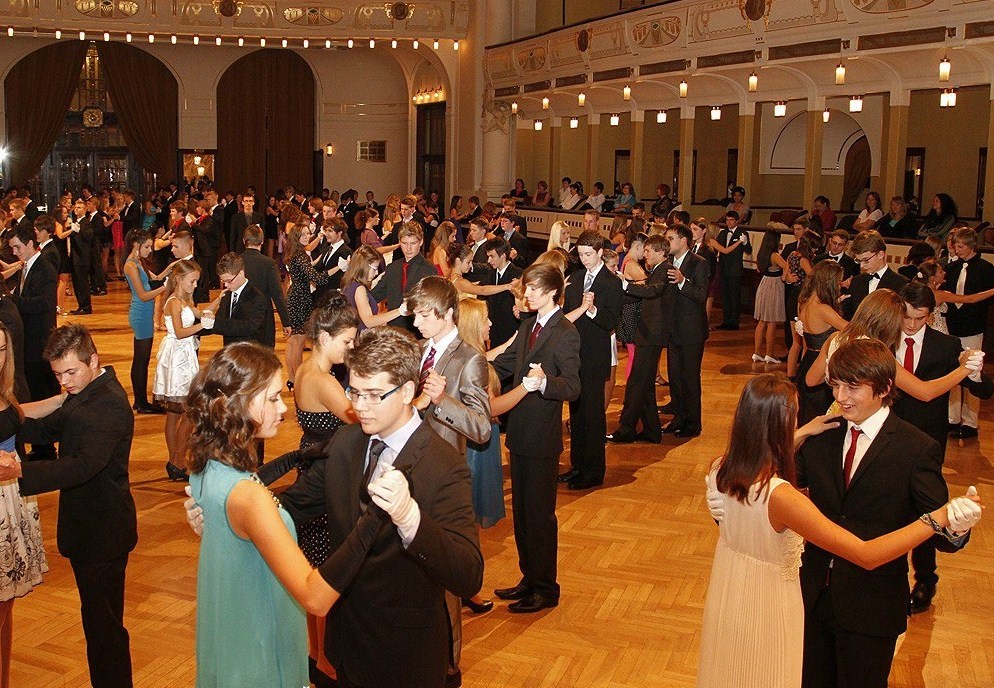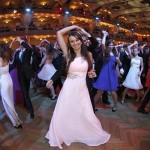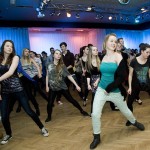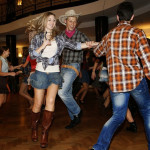During the winter and early spring, ballrooms host dozens of dancing events, renewing a tradition which still remains alive in the Czech Republic. The dance and etiquette classes for high school students continue to be an inevitable rite of passage into adulthood
Visitors to Prague in the early months of the year may be amazed to frequently see, in metro carriages, girls in evening dresses and boys in suits and ties. The dance season is a tradition which is still very much alive in the Czech Republic. Between November and April every institution, from the government to the village clubs, organizes dance evenings.
If the ballrooms are many, the schools are even more widespread, with their main activity being the courses for high school students. The boys aged around sixteen compete in their steps of waltz, the cha-cha-cha and the foxtrot to prepare for the high school dance, an event that marks the end of higher education, still rooted in the local culture.
The dance classes in the Czech conception are a unique phenomenon. Firstly, the teacher Zdeněk Řehák observes its specificity in mass character, an experience to share with peers. “Elsewhere classes are individual, or at most in pairs, perhaps taking place in the gym or at the teacher’s home, but generally lack the necessary atmosphere to dance, because dance is a social affair”. Řehák teaches at the school of the National House of Vinohrady and Žofín Palace, among the most dated of the capital, visited each year by about two thousand boys. The group classes exist in Slovakia, Austria and to a certain extent in Germany, “a prerogative of central Europe, a remnant of the Austro-Hungarian Empire”, says Jiří Plamínek, vice president of the Dance teachers association of the Czech Republic. Secondly, “they are a fundamental part of basic education” because they open the doors to adulthood. In addition to the study of the steps, they provide lessons on etiquette and the model of conduct to be respected both in society and on the dance floor.
 Courses start in September, in addition to regular classes, they also consist of a couple of meetings open to the family and the final dance. There is even an evening in which, in front of a buffet, you must maneuver between the appetizers without making a mess. “The first full lesson is a real party, the boys take their entry into the club seriously, they no longer feel like a community of students, but like adults”, says the teacher Danuše Chytrá in the documentary “A Czech phenomenon: dance lessons”, shot in 2005. A phenomenon that actually still affects the majority of the boys. There are those who enrol “to learn to dance, not to sit at the table and stare when invited to a wedding”, and those who appreciate the old-fashioned atmosphere, classical music and fine clothes. Dozens of girls devote their time to searching for a dress for the High school dance months in advance. Many others are aware of guaranteeing themselves essential knowledge for the future, the need to learn how to behave at the theatre or at the restaurant. Yet these also include simple gestures such as how to greet people in the right way, and how to present themselves in a manner leaving a good impression on those they face even in a job interview, as well as choosing suitable clothes for various occasions. The formal attire is already required in the classes, but sometimes the rules are less strict in order not to discourage students. To attract them, they try to run the courses with a touch of humour or devise diversions, as is the case at the school of Jakub Vavruška who teaches at the Municipal House. Young bands are called upon rather than classical orchestras, and theme nights are organized, like the country or Latin, disco or an incursion in modern dances with hip hop teachers.
Courses start in September, in addition to regular classes, they also consist of a couple of meetings open to the family and the final dance. There is even an evening in which, in front of a buffet, you must maneuver between the appetizers without making a mess. “The first full lesson is a real party, the boys take their entry into the club seriously, they no longer feel like a community of students, but like adults”, says the teacher Danuše Chytrá in the documentary “A Czech phenomenon: dance lessons”, shot in 2005. A phenomenon that actually still affects the majority of the boys. There are those who enrol “to learn to dance, not to sit at the table and stare when invited to a wedding”, and those who appreciate the old-fashioned atmosphere, classical music and fine clothes. Dozens of girls devote their time to searching for a dress for the High school dance months in advance. Many others are aware of guaranteeing themselves essential knowledge for the future, the need to learn how to behave at the theatre or at the restaurant. Yet these also include simple gestures such as how to greet people in the right way, and how to present themselves in a manner leaving a good impression on those they face even in a job interview, as well as choosing suitable clothes for various occasions. The formal attire is already required in the classes, but sometimes the rules are less strict in order not to discourage students. To attract them, they try to run the courses with a touch of humour or devise diversions, as is the case at the school of Jakub Vavruška who teaches at the Municipal House. Young bands are called upon rather than classical orchestras, and theme nights are organized, like the country or Latin, disco or an incursion in modern dances with hip hop teachers.
The teachers repeat that dancing is simple, like learning to write. “Dance is not a matter of talent, but of will and concentration, anyone can do it”, says Plamínek. “At first I really did not want to participate in the classes, but soon I started to enjoy the dancing”, Tereza, a university student, tells me. “There is an atmosphere that until then, a teenager has not experienced elsewhere. One only learns the basic steps, but we manage to execute them well, and in time to the music”. Absolute beginners, sometimes driven by their parents, are in fact able to reproduce the moves of twenty dances after just a few lessons, from standard types to Latin American ones, up to the popular polka, the national dance of which the Czechs are very proud.
Right at the time when polka was born, was also the time in which dance classes originated. It’s 1830, and the music teacher Josef Neruda, while observing a peasant dance, elaborates on his steps to the melody of this animated dance, launched in Prague and then in Baden, conquering all of Europe. The nineteenth century was also a period of national revival, and its supporters love the polka for its local touch. Composed by famous musicians such as Johann Strauss and Antonín Dvořák, it would find a lot of space in the productions of Bedřich Smetana. The Czech composer was the first person to make use of it in a classic tone, and to fully develop musical nationalism. If until then we would meet up to dance in bars, public places and squares, in cities first dance halls and schools appeared. In 1841 Žofín palace, on an island on the Vltava, hosted the first ball, involving influential names of the national revival such as writers Božena Němcová and Jan Neruda, the poet who in 1863 together with Smetana gave a demonstration of another typical dance, the česká beseda or Bohemian square dance.
The format of the current dance and etiquette classes dates back to the First Republic. It is surprising that such a petty bourgeois institution was tolerated by the communist regime, even to the point of it being a compulsory subject in the curriculum of high schools and professional institutes until 1989, when it became optional. In the last thirty years, the dances and the objective have remained the same but the number of subscribers has decreased, especially in Prague where young people have many other options for their free time. In contrast, adult courses are more popular every year. The tv program StarDance has infused courage and filled courses proving that everyone can move to the rhythm of music. Those who never attempted it in their youth, feel the need with time, maybe because they are invited to a company ball or party. Knowing the basics of dance is once again becoming a social need. For some it is an opportunity for meeting others and for diversion after a day of work, for others the need to combat stress or keep fit. The Zumba is very popular, since it combines dance and fitness. Finally, there is no lack of men, who having felt satisfied with the first course, enrol in subsequent years. Many come in pairs, while other romances begin with classmates, because the dance floor is also a place that brings men and women together.
The schools therefore show no signs of the crisis, being favoured by the number of events offered each season. February is the peak month for parties in sumptuous locations: the Czechoslovak Ball has illuminated the rooms of the Municipal House for over forty years, the Žofín palace offers romantic evenings on the riverfront and the Crystal Ball at the Clam Gallas Palace, linked to the celebrations of Baroque Carnival, allows you to show off original costumes and masks. The most prestigious event on the Czech calendar, however, is the Opera Ball, an event marked by its opulence and simultaneously an initiative for charity that each year attracts celebrities and aristocrats. The dancing season was already popular during the Austro-Hungarian Empire and the First Republic, but Prague would have to wait until 1948 to have its own Opera Ball. The communist regime immediately stopped the tradition and the dance, which was reintroduced for a few years after the Velvet Revolution, became an annual event only in 2009. Some teachers are still skeptical about it. Zdeněk Řehák, who has never participated in it, calls it “a parade where occasionally you dance a little”. “The dance nights in the countryside are more sincere, they dance more”, echoes Jakub Vavruška, “the Opera Ball is a social issue, a way to meet someone, create a business card and eat good food”. An example of these simple balls can be seen in the film Hoří, má panenko from the director Miloš Forman (1967), a comedy which takes place at a firemen’s ball in a small Czech town.
Whether it is a for the Opera Ball, for hunters or lawyers balls, for those in high school or university, you can not look bad. In the Czech Republic you lose respect in the eyes of others if you do not master at least the basics of the dance.
by Sabrina Salomoni







